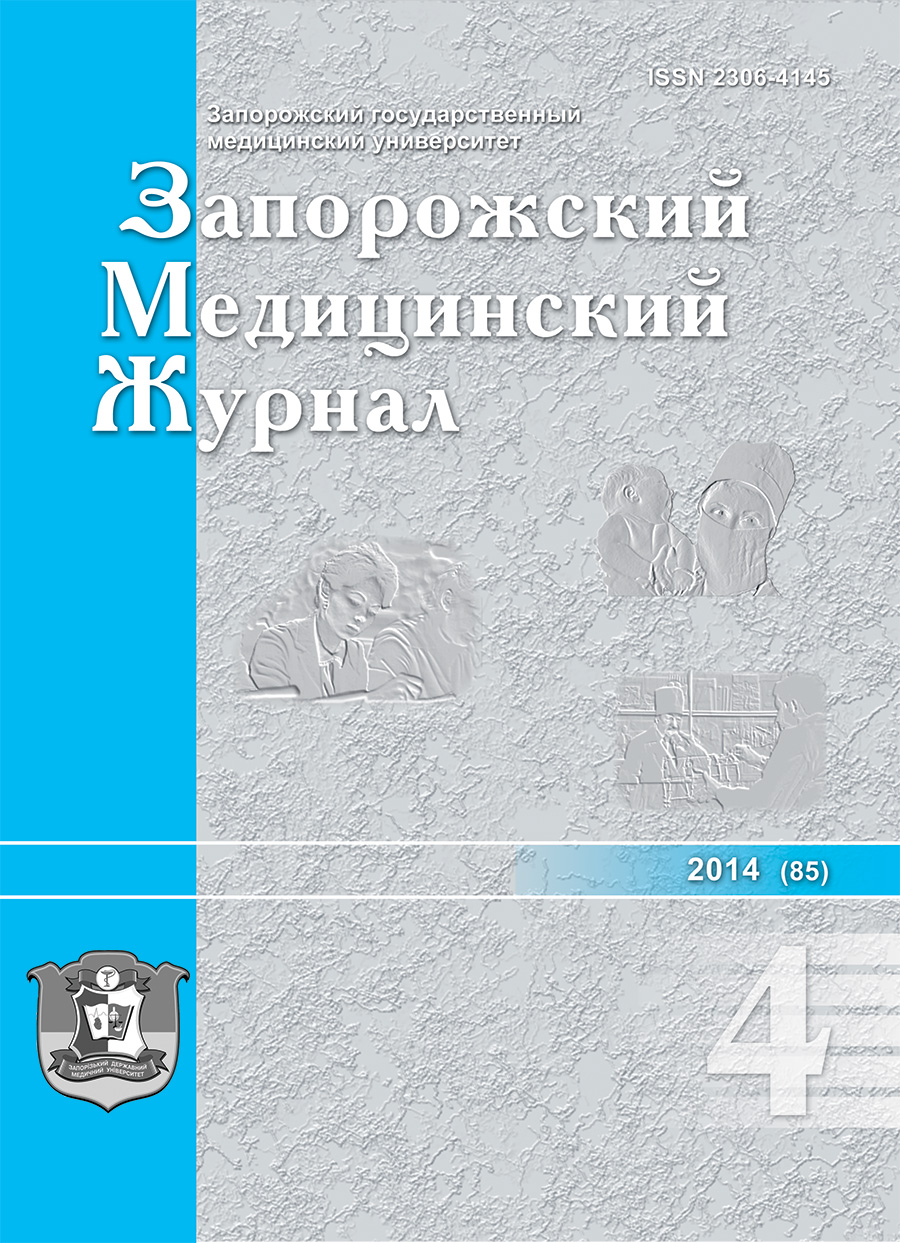Evaluating the effectiveness of endoscopic treatment of gastroduodenal bleeding in children
DOI:
https://doi.org/10.14739/2310-1210.2014.4.27315Keywords:
Gastroduodenal Bleeding, Children, EndoscopyAbstract
Introduction: One of the current problems of emergency abdominal child surgery are gastric (GU) and duodenal ulcer (DU). Thus, domestic and foreign researchers have noted that the prevalence of peptic ulcer disease in the pediatric population in recent years has nearly doubled. GU and duodenal ulcer occurs with frequency 1,6-2,7 cases per 1000 children and is 7-12 % of diseases of the gastrointestinal tract in children. Along with the growing incidence of this disease, there is a tendency of the number of complications increase.
One of the major complications that pose a threat to a child's life is gastroduodenal bleeding. InUkraine, the rate for the last five years has increased by 14% and in the structure of hemorrhagic complications of diseases of the gastrointestinal tract up to 60 % .
Despite the fact that endoscopic hemostasis is considered the "gold standard" treatment of gastroduodenal ulcer bleeding, their effectiveness in the primary use and application in cases of relapse in childhood actively discussed.
Insufficient number of pediatric surgeons work on the effectiveness of the treatment of these complications with the use of modern minimally invasive technologies is largely determined by the relevance and purpose of the present study.
Research objective. To analyze the efficacy of endoscopic treatment of bleeding and recurrence of gastric and duodenal ulcers in children.
Material and research methods. Results of the treatment of 57children with acute bleeding from gastric and duodenal ulcers in age from 2 to 16 years who were treated in the surgical departments of pediatric surgery clinics Dnepropetrovsk State Medical Academy and Zaporozhye State Medical University were presented. 38 (67 %) were girls, 19 (33 %) - boys.
All patients were admitted to the intensive care unit and undergone clinical, laboratory examinations, complex etiopathogenetic treatment (infusion, hemostatic, substitution, antisecretory therapy) and fibrogastroduodenoscopy (EGD) for diagnostic and therapeutic purposes. Activity of the bleeding was defined with scale by Forrest (Forrest-Rosch W., 1986) during endoscopy exam. Endoscopic electrocoagulation monoelektrod using fiberoptic gastroduodenoscopy «Olympus» UES 10 was done. Injection of 0.18% solution of adrenaline with endoscopic injection needle 5Ch in different volumes through the working channel of the endoscope and therapy in combination with electrocautery was done. Treatment effectiveness monitoring was based on clinical, laboratory data and endoscopic studies.
Results of research. The study found that duodenal ulcer bleeding substantially prevailed and was found in 44 children, whereas bleeding from gastric ulcer were found in 13 patients. Thus at 52 (91 %) there was no history information of the diagnosed ulcer. Chronic abdominal pain with PUD previously was recorded only in 9% of cases.
Bleeding duration up to 6 hours before admission was detected in 39% of children, between 6 and 24 hours – in 45% and more than 24 hours – in 16% of patients. During EGD macroscopic acute ulcers appearance was detected in the majority (86 %) of children, 32% of them in the last month had mentioned nonsteroidal anti-inflammatory drugs intake and 41% of patients noted aggressive and soft products intake. Ulcers size ranged approximately 5-7 mm. Contamination of Helicobacter pylori serological test according to the level of IgG antibodies was detected in 89.8% of children. Variations in the levels of pepsinogen and serum gastrin in 98 % of children do not cross the boundaries of age-reference values. The clinical picture was characterized by vomiting blood 15% of patients, vomiting "coffee grounds" was detected in 72 % of children, melena was observed in 61% of cases.
Primary hemostasis using endoscopic electrocautery combinations and epinephrine injection solution was effective in 48 (84 %) children. 9 patients that undergone only electrocoagulation treatment on the 2nd day were diagnosed rebleeding, which required re-EGD using a combined endoscopic hemostasis. According to the results of clinical laboratory and endoscopic control full bleeding stop was observed during the first 2 days of children stay in hospital.
Conclusions .
1. Study improved predominance of duodenal ulcer bleeding in children.
2. History of alcohol and/or nonsteroidal anti-inflammatory drugs intake increases the risk of acute gastric or duodenum ulcers complicated by bleeding.
3. Use of surgery endoscopic hemostasis using combined coagulation- injection method on the background of the hemostatic and parenteral antisecretory therapy for primary and preventive stop ulcer bleeding ensures maximum efficiency of complex treatment in the practice.
References
Alekberzade A. V., & Lipnitskij E.M. (2004). E`ndoskopicheskij gemostaz u bol'nykh s krovotochaschej pepticheskoj yazvoj [Endoscopic hemostasis in patients with bleeding peptic ulcer]. Surgery, 6, 63–66. [in Ukrainian].
Fomin, P. D., Hichka, S. G., & Scherbyna, M. V. (2008). Patomorfolohichni zminy hastralnoho viddilu shlunka pry hostro krovotochyvykh piloroduodenalnykh vyrazkakh [Pathomorphological gastral changes of the stomach in acute bleeding piloroduodenal ulcer]. Ukrainskyi zhurnal khirurhii, 1, 18–21. [in Ukrainian].
Yuldashev, R. Sh. (2004) Taktika khirurgicheskogo lecheniya «trudnykh» krovotochaschih duodenal'nykh yazv [Surgical treatment of "difficult" bleeding duodenal ulcers]. Eksperymentalna i klinichna medytsyna, 3, 173–175. [in Ukrainian].
Yaroshenko, K. O. (2013) Udoskonalennia kompleksu diahnostychnych ta likuvalnukh zakhodiv pry hastrokrovotochyvkh vyrazkakh piloroduodenalnoi zony (Avtoref. dis…kand. med. nauk). [Improvement of the diagnostic and therapeutic measures complex in case of acute bleeding of pyloroduodenal area ulcers]. (Extended abstract of candidate’s thesis). Dnipropetrovsk. [in Ukrainian].
Church, N. I., & Palmer, K. R. (2003) Ulcer and nonvariceal bleeding. Ebdoscopy, 35(1), 22–26.
Guglielmi, A, Ruzzenente, A., & Sandri, M. (2002). Risk assessment and prediction of rebleeding in bleeding gastroduodenal ulcer. Endoscopy, 34(10), 778–786. doi 10.1055/s-2002-34261.
Seves, I., Sousa, C., & Luz, Z. (2002). Prognostic value of the finding of blood/clots in the stomach at the emergency upper endoscopy. Acta Med Port, 15(6), 413–416.
Downloads
How to Cite
Issue
Section
License
Authors who publish with this journal agree to the following terms:
Authors retain copyright and grant the journal right of first publication with the work simultaneously licensed under a Creative Commons Attribution License that allows others to share the work with an acknowledgement of the work's authorship and initial publication in this journal. 

